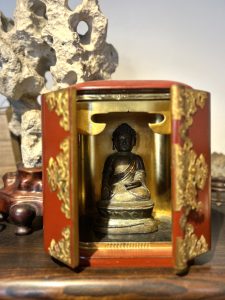秋の味覚を再確認いたしました(愛知県名古屋市千種区姫池通 骨董買取 古美術風光舎)
2024.12.04
師走ともなると年末年始に向けての準備やイベント事などで楽しみな反面、カレンダーに予定が詰まってくると気忙しくもあります。大掃除も毎年早めに始めようと思うのですが、重い腰がなかなか上がりません。
体調を崩しがちな季節でもありますのでくれぐれもご注意ください。
本日、月初めということもあり、ご近所の城山八幡宮へお参りにいきました。七五三参りのご家族にも遭遇し、久しぶりに可愛い着物姿を見させていただきました。お天気もよく、あまり信心深いほうではありませんが、手を合わせると清々しい気持ちになります。
風光舎にも最近仲間入りした小さな仏像がございます。扉を開けると静かに座っていらっしゃり、お顔を眺めるだけで心が落ち着くのですが、扉を開く時になぜか緊張してしまいます。

さて先日、掘りたての新鮮な里芋をたくさんいただきました。秋といえば美味しいものが多く出回りますが、里芋も美味しい季節です。貯蔵性が高いため1年中出回っていますが、秋から冬にかけてが旬の野菜です。
いつもスーパーで購入するので気づきにくいのですが、子芋がたくさんくっ付いた状態で収穫されるのですね。ポキポキと切り離す作業が新鮮でした。里芋は土の表面から浅いところで塊になって育ち、親芋から子芋、孫芋と分裂しながら増えていくそうです。このように親、子、孫と次々と増えていくことから子孫繁栄の象徴とされ、お節料理に使われるようになったとか。そういえば我が家のお雑煮には必ず里芋が入っておりました。
実のところ我が家ではジャガイモやサツマイモほどはレギュラー入りしている野菜ではないのですが、昔は芋といえば里芋を指していたようですね。日本の食文化において古い歴史を持っているようです。
里芋が日本へ渡来してきた経緯は諸説あるようで、紀元前に中国から渡来したという説と、南方からの太平洋民族の渡来により伝わったという説があります。いずれにせよ稲の渡来時期よりも古いとされています。
日本で稲作が始まった弥生時代以前は焼き畑農業が行われており、主な作物は里芋で、稲作以前の主食だったと考えられています。平安時代の「延喜式」には里芋の栽培方法の記載があり、穀類があまり豊かでなかった時代に里芋は重要な作物でした。ジャガイモやサツマイモが食べられるようになるのは江戸時代になってからのことだそうです。日本人のDNAに里芋の味は刷り込まれているのかもしれませんね。
里芋は追熟は必要なく収穫後すぐに食べられるそうですが、収穫した里芋は土を落とさず天日干しで保存すると1ケ月ほど持つとのこと。我が家は芋好きなので頂いた里芋は全て煮っころがしとなり完食いたしました。
自分では皮をむく作業や、手が痒くなる煩わしさからスーパーで手が出にくい野菜でしたので、久しぶりにねっとりと甘い里芋を堪能でき良い機会となりました。里芋を洗った後にしっかりと乾かしてから剥くのがコツだとか。カロリーが低くカリウムが多く含まれむくみをとる効果があるそう有難いです。ハマると何度も買う癖があるので、しばらく頻繁に食卓に登場することでしょう。
それでは、また次の機会に。(スタッフH)
While we look forward to the end of the year and the New Year with all their preparations and events, we are also very busy as our calendars fill up with plans. I try to start cleaning early every year, but I can never seem to get up the heavy lifting.
It is also the season when people tend to get sick, so please take care.
Today, as it is the first day of the month, I went to visit Shiroyama Hachimangu Shrine in my neighborhood. I met a family visiting for the 75th birthday and saw them dressed in cute kimonos for the first time in a long time. The weather was fine, and although I am not a very religious person, I felt refreshed when I put my hands together in prayer.
There is a small Buddha statue that has recently joined the Fumikosha. When I open the door, I see him sitting quietly, and just looking at his face calms me down, but for some reason I get nervous when I open the door.
Well, the other day we received a lot of freshly dug taro. Autumn is the season when many delicious foods are available, and taro is also delicious. Because of its high storability, taro is available all year round, but it is in season from fall to winter.
It is hard to notice because we always buy them at the supermarket, but they are harvested with a lot of baby taro attached to them. The process of separating them from the taro was a new experience for me. I heard that taro grows in clumps at a shallow depth from the soil surface, and grows by dividing from the parent taro to the offspring and grandchild taro. Since taro grows in clumps one after another from parent to child to grandchild, it is said to symbolize the prosperity of offspring and is used for osechi (New Year dishes). Come to think of it, taro was always included in my family’s ozoni.
Actually, taro is not a regular vegetable in our house as much as potato or sweet potato, but in the old days, taro seemed to be the most common vegetable in our house. It seems to have a long history in Japanese food culture.
There are various theories on how taro came to Japan. Some say that it came from China in B.C., while others say that it was introduced by the arrival of Pacific peoples from the south. Either way, it is believed to be older than the arrival of rice.
Before the Yayoi period, when rice cultivation began in Japan, people farmed in slash-and-burn agriculture, and the main crop was taro, which is thought to have been the staple food before rice cultivation. The Engishiki (Engi Shiki) of the Heian period (794-1185) describes the cultivation of taro, and taro was an important crop at a time when grains were not so plentiful. It was not until the Edo period (1603-1867) that people began to eat potatoes and sweet potatoes. The taste of taro may have been imprinted in the DNA of Japanese people.
Taro does not need to be ripened and can be eaten immediately after harvesting, but if harvested taro is stored in the sun without removing the soil, it will keep for about one month. We are taro lovers, so we ate all the taro we received.
It was a vegetable that was hard for me to buy at the supermarket because of the peeling process and itchy hands, so it was a good opportunity for me to enjoy the sticky sweet taro for the first time in a while. I heard that the secret is to dry the taro thoroughly after washing it before peeling it. It is low in calories and contains a lot of potassium, which is said to help reduce swelling. I have a habit of buying them again and again once I get hooked on them, so I am sure they will be on my table frequently for some time to come.
See you next time. (Staff H)
*******************
ご実家の整理やお片付けなどをされている方のご相談などが多くございます。
お片付けなどくれぐれもご無理のないようになさってくださいませ。
風光舎では古美術品や骨董品の他にも絵画や宝石、趣味のお品など様々なジャンルのものを買受しております。
お片付けをされていて、こういうものでもいいのかしらと迷われているものでも、どうぞお気軽にご相談下さいませ。
また風光舎は、出張買取も強化しております。ご近所はもちろん、愛知県内、岐阜県、三重県その他の県へも出張いたします。
まずは、お電話お待ちしております。
愛知県名古屋市千種区姫池通
骨董 買取【古美術 風光舎 名古屋店】
TEL052(734)8444
10:00-18:00 OPEN
#出張買取#骨董#古美術#骨董品#絵画#版画#茶道具#刀剣#彫刻

